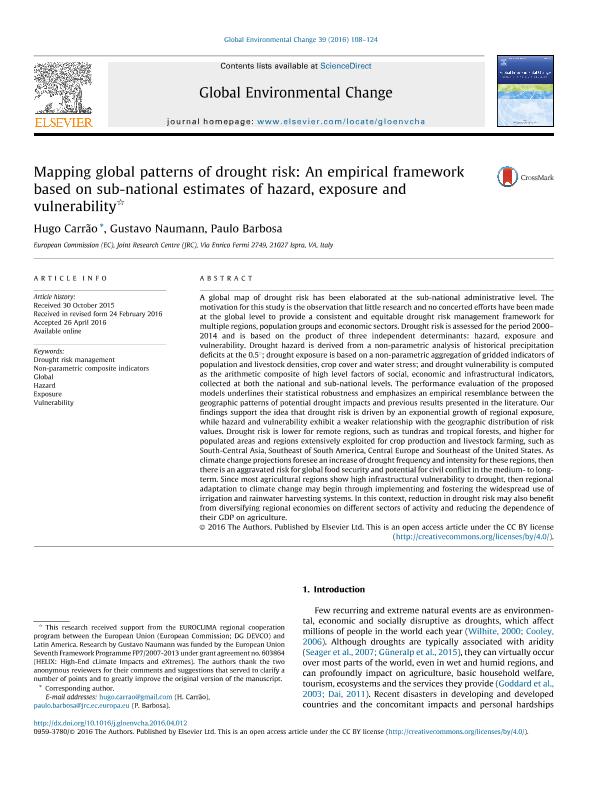Mostrar el registro sencillo del ítem
dc.contributor.author
Carrão, Hugo
dc.contributor.author
Naumann, Gustavo

dc.contributor.author
Barbosa, Paulo
dc.date.available
2018-09-14T19:15:35Z
dc.date.issued
2016-07
dc.identifier.citation
Carrão, Hugo; Naumann, Gustavo; Barbosa, Paulo; Mapping global patterns of drought risk: An empirical framework based on sub-national estimates of hazard, exposure and vulnerability; Elsevier; Global Environmental Change; 39; 7-2016; 108-124
dc.identifier.issn
0959-3780
dc.identifier.uri
http://hdl.handle.net/11336/59771
dc.description.abstract
A global map of drought risk has been elaborated at the sub-national administrative level. The motivation for this study is the observation that little research and no concerted efforts have been made at the global level to provide a consistent and equitable drought risk management framework for multiple regions, population groups and economic sectors. Drought risk is assessed for the period 2000-2014 and is based on the product of three independent determinants: hazard, exposure and vulnerability. Drought hazard is derived from a non-parametric analysis of historical precipitation deficits at the 0.5°; drought exposure is based on a non-parametric aggregation of gridded indicators of population and livestock densities, crop cover and water stress; and drought vulnerability is computed as the arithmetic composite of high level factors of social, economic and infrastructural indicators, collected at both the national and sub-national levels. The performance evaluation of the proposed models underlines their statistical robustness and emphasizes an empirical resemblance between the geographic patterns of potential drought impacts and previous results presented in the literature. Our findings support the idea that drought risk is driven by an exponential growth of regional exposure, while hazard and vulnerability exhibit a weaker relationship with the geographic distribution of risk values. Drought risk is lower for remote regions, such as tundras and tropical forests, and higher for populated areas and regions extensively exploited for crop production and livestock farming, such as South-Central Asia, Southeast of South America, Central Europe and Southeast of the United States. As climate change projections foresee an increase of drought frequency and intensity for these regions, then there is an aggravated risk for global food security and potential for civil conflict in the medium- to long-term. Since most agricultural regions show high infrastructural vulnerability to drought, then regional adaptation to climate change may begin through implementing and fostering the widespread use of irrigation and rainwater harvesting systems. In this context, reduction in drought risk may also benefit from diversifying regional economies on different sectors of activity and reducing the dependence of their GDP on agriculture.
dc.format
application/pdf
dc.language.iso
eng
dc.publisher
Elsevier

dc.rights
info:eu-repo/semantics/openAccess
dc.rights.uri
https://creativecommons.org/licenses/by-nc-nd/2.5/ar/
dc.subject
Drought Risk Management
dc.subject
Exposure
dc.subject
Global
dc.subject
Hazard
dc.subject
Non-Parametric Composite Indicators
dc.subject
Vulnerability
dc.subject.classification
Ciencias Medioambientales

dc.subject.classification
Ciencias de la Tierra y relacionadas con el Medio Ambiente

dc.subject.classification
CIENCIAS NATURALES Y EXACTAS

dc.title
Mapping global patterns of drought risk: An empirical framework based on sub-national estimates of hazard, exposure and vulnerability
dc.type
info:eu-repo/semantics/article
dc.type
info:ar-repo/semantics/artículo
dc.type
info:eu-repo/semantics/publishedVersion
dc.date.updated
2018-09-14T13:15:13Z
dc.journal.volume
39
dc.journal.pagination
108-124
dc.journal.pais
Países Bajos

dc.journal.ciudad
Amsterdam
dc.description.fil
Fil: Carrão, Hugo. European Commission. Joint Research Centre; Italia
dc.description.fil
Fil: Naumann, Gustavo. European Commission. Joint Research Centre; Italia. Consejo Nacional de Investigaciones Científicas y Técnicas; Argentina
dc.description.fil
Fil: Barbosa, Paulo. European Commission. Joint Research Centre; Italia
dc.journal.title
Global Environmental Change

dc.relation.alternativeid
info:eu-repo/semantics/altIdentifier/url/http://www.sciencedirect.com/science/article/pii/S0959378016300565
dc.relation.alternativeid
info:eu-repo/semantics/altIdentifier/doi/http://dx.doi.org/10.1016/j.gloenvcha.2016.04.012
Archivos asociados
